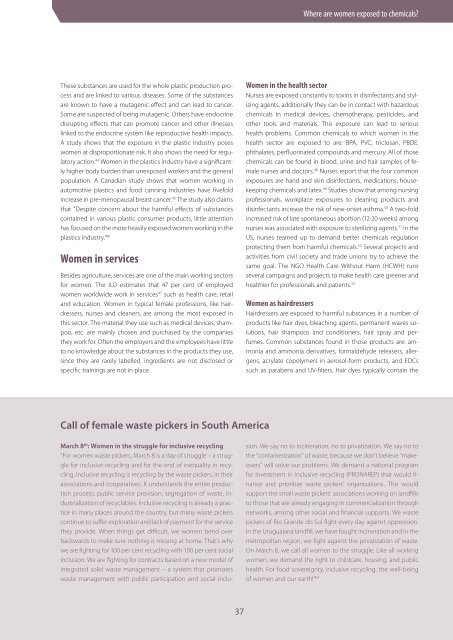Women and Chemicals
1ToENNR
1ToENNR
You also want an ePaper? Increase the reach of your titles
YUMPU automatically turns print PDFs into web optimized ePapers that Google loves.
Where are women exposed to chemicals?<br />
These substances are used for the whole plastic production process<br />
<strong>and</strong> are linked to various diseases. Some of the substances<br />
are known to have a mutagenic effect <strong>and</strong> can lead to cancer.<br />
Some are suspected of being mutagenic. Others have endocrine<br />
disrupting effects that can promote cancer <strong>and</strong> other illnesses<br />
linked to the endocrine system like reproductive health impacts.<br />
A study shows that the exposure in the plastic industry poses<br />
women at disproportionate risk. It also shows the need for regulatory<br />
action. 44 <strong>Women</strong> in the plastics industry have a significantly<br />
higher body burden than unexposed workers <strong>and</strong> the general<br />
population. A Canadian study shows that women working in<br />
automotive plastics <strong>and</strong> food canning industries have fivefold<br />
increase in pre-menopausal breast cancer. 45 The study also claims<br />
that “Despite concern about the harmful effects of substances<br />
contained in various plastic consumer products, little attention<br />
has focused on the more heavily exposed women working in the<br />
plastics industry.“ 46<br />
<strong>Women</strong> in services<br />
Besides agriculture, services are one of the main working sectors<br />
for women. The ILO estimates that 47 per cent of employed<br />
women worldwide work in services 47 such as health care, retail<br />
<strong>and</strong> education. <strong>Women</strong> in typical female professions, like hairdressers,<br />
nurses <strong>and</strong> cleaners, are among the most exposed in<br />
this sector. The material they use such as medical devices, shampoo,<br />
etc. are mainly chosen <strong>and</strong> purchased by the companies<br />
they work for. Often the employers <strong>and</strong> the employees have little<br />
to no knowledge about the substances in the products they use,<br />
since they are rarely labelled, ingredients are not disclosed or<br />
specific trainings are not in place.<br />
<strong>Women</strong> in the health sector<br />
Nurses are exposed constantly to toxins in disinfectants <strong>and</strong> stylizing<br />
agents, additionally they can be in contact with hazardous<br />
chemicals in medical devices, chemotherapy, pesticides, <strong>and</strong><br />
other tools <strong>and</strong> materials. This exposure can lead to serious<br />
health problems. Common chemicals to which women in the<br />
health sector are exposed to are: BPA, PVC, triclosan, PBDE,<br />
phthalates, perfluorinated compounds <strong>and</strong> mercury. All of those<br />
chemicals can be found in blood, urine <strong>and</strong> hair samples of female<br />
nurses <strong>and</strong> doctors. 48 Nurses report that the four common<br />
exposures are h<strong>and</strong> <strong>and</strong> skin disinfectants, medications, housekeeping<br />
chemicals <strong>and</strong> latex. 49 Studies show that among nursing<br />
professionals, workplace exposures to cleaning products <strong>and</strong><br />
disinfectants increase the risk of new-onset asthma. 50 A two-fold<br />
increased risk of late spontaneous abortion (12-20 weeks) among<br />
nurses was associated with exposure to sterilizing agents. 51 In the<br />
US, nurses teamed up to dem<strong>and</strong> better chemicals regulation<br />
protecting them from harmful chemicals. 52 Several projects <strong>and</strong><br />
activities from civil society <strong>and</strong> trade unions try to achieve the<br />
same goal. The NGO Health Care Without Harm (HCWH) runs<br />
several campaigns <strong>and</strong> projects to make health care greener <strong>and</strong><br />
healthier for professionals <strong>and</strong> patients. 53<br />
<strong>Women</strong> as hairdressers<br />
Hairdressers are exposed to harmful substances in a number of<br />
products like hair dyes, bleaching agents, permanent waves solutions,<br />
hair shampoos <strong>and</strong> conditioners, hair spray <strong>and</strong> perfumes.<br />
Common substances found in those products are: ammonia<br />
<strong>and</strong> ammonia derivatives, formaldehyde releasers, allergens,<br />
acrylate copolymers in aerosol-form products, <strong>and</strong> EDCs<br />
such as parabens <strong>and</strong> UV-filters. Hair dyes typically contain the<br />
Call of female waste pickers in South America<br />
March 8 th : <strong>Women</strong> in the struggle for inclusive recycling<br />
“For women waste pickers, March 8 is a day of struggle – a struggle<br />
for inclusive recycling <strong>and</strong> for the end of inequality in recycling.<br />
Inclusive recycling is recycling by the waste pickers, in their<br />
associations <strong>and</strong> cooperatives. It underst<strong>and</strong>s the entire production<br />
process: public service provision, segregation of waste, industrialization<br />
of recyclables. Inclusive recycling is already a practice<br />
in many places around the country, but many waste pickers<br />
continue to suffer exploration <strong>and</strong> lack of payment for the service<br />
they provide. When things get difficult, we women bend over<br />
backwards to make sure nothing is missing at home. That’s why<br />
we are fighting for 100 per cent recycling with 100 per cent social<br />
inclusion. We are fighting for contracts based on a new model of<br />
integrated solid waste management – a system that promotes<br />
waste management with public participation <strong>and</strong> social inclu-<br />
sion. We say no to incineration, no to privatization. We say no to<br />
the “containerization” of waste, because we don’t believe “makeovers”<br />
will solve our problems. We dem<strong>and</strong> a national program<br />
for investment in inclusive recycling (PRONAREP) that would finance<br />
<strong>and</strong> prioritize waste pickers’ organizations. This would<br />
support the small waste pickers’ associations working on l<strong>and</strong>fills<br />
to those that are already engaging in commercialization through<br />
networks, among other social <strong>and</strong> financial supports. We waste<br />
pickers of Rio Gr<strong>and</strong>e do Sul fight every day against oppression.<br />
In the Uruguaiana l<strong>and</strong>fill, we have fought incineration <strong>and</strong> in the<br />
metropolitan region, we fight against the privatization of waste.<br />
On March 8, we call all women to the struggle. Like all working<br />
women, we dem<strong>and</strong> the right to childcare, housing, <strong>and</strong> public<br />
health. For food sovereignty, inclusive recycling, the well-being<br />
of women <strong>and</strong> our earth!” 64<br />
37


